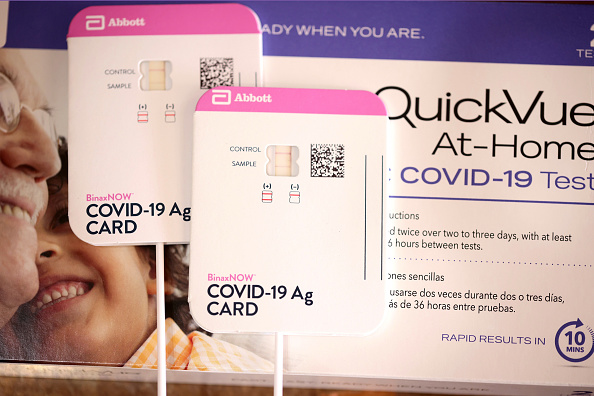As of May 2022, the U.S. is experiencing another uptick in the number of COVID-19 cases. High rates of infection in Europe and Asia, along with the continued emergence of new sub-variants, such as omicron BA.4 and BA.5, raise concerns that another surge could be on the way.
Even though demand for COVID-19 tests greatly overwhelmed supply earlier in the pandemic, rapid home tests are more available today. While home tests provide a quick, accurate result, the flip side is that many test results are no longer reported to health authorities. The power behind widely available over-the-counter testing is that people can quickly and conveniently know their infection status early on to prevent spreading the virus to others.
We’re part of a team at UMass Chan Medical School that has been studying COVID-19 molecular, or PCR, and antigen test performance over the past two years. During this time, we’ve helped multiple companies generate the data needed to move their products through the Food and Drug Administration’s Emergency Use Authorization process and into commercial development.
We have also conducted large-scale, real-world studies to understand how over-the-counter rapid tests perform in comparison to PCR tests in detecting different variants of SARS-CoV-2, the virus that causes COVID-19, including among people without symptoms. We have also studied whether mass distribution of rapid antigen tests prior to a surge helps prevent spread, and whether users of these tests are likely to report the results to health departments.
These studies are beginning to provide researchers like us with evidence about how these tests perform and how we can use them to make the best public health recommendations moving forward.
At-home tests and the omicron variant
When the omicron variant emerged in late November 2021, scientists quickly responded to determine how PCR and rapid tests performed against this new variant.
Researchers have demonstrated that an infected individual will test positive on a PCR test one to two days before an antigen test. This is because a PCR test works by amplifying the genetic material in a sample and is therefore able to detect extremely small amounts of viral material. In contrast, an over-the-counter test can only detect the viral proteins present in the sample.
Early in the omicron surge, around December 2021, people wondered about the ability of rapid tests to detect the new variant. Additionally, some preliminary tests proved that rapid tests that identify the omicron variant showed a one-to-two-day delay in a positive result compared to tests performed with the delta variant. This led to an FDA announcement on Dec. 28, urging caution in the use of tests for the detection of omicron.
The role of rapid antigen tests
During that time, our group was working on a study examining the performance of over-the-counter tests in the general population. We used data from this study to look at the performance of these tests both before and after omicron became the dominant variant in the United States. Our study, which has not yet been peer-reviewed, was unique because it was testing people for the COVID-19 virus over the course of two weeks, and thus we were able to observe emerging infections.
In our analysis of approximately 150 individuals who tested positive for SARS-CoV-2 during the study, we made two major observations. The first is that over-the-counter tests were able to detect the omicron variant as well as the delta variant.
Another is that serial testing – two tests taken 24 to 36 hours apart – is critical with rapid tests. This is because we observed that if a person had an infection that was detected by a PCR test for at least two days in a row, one or two of the over-the-counter tests taken over the same time also detected the infection more than 80% of the time. In comparison, a single rapid test detected far fewer infections.
Previous research by our study team and others suggests that over-the-counter tests are more likely to detect an infection among people who are actively contagious.
Over-the-counter tests and reporting
In 2021, we evaluated whether mass distribution of over-the-counter tests can reduce transmission of the virus by comparing new cases in Washtenaw County, Michigan, which has a population of 370,000. Two communities that make up 140,000 of the total county population used more rapid tests and prevented an average of 40 cases of COVID-19 per day during the delta surge. Our findings suggest that rapid antigen tests are a critical public health tool that can help reduce the spread of disease during a surge.
But much of the research to date on over-the-counter SARS-CoV-2 tests has been done in controlled study settings. We want to know whether the performance of tests in a more realistic environment mirrors that observed in clinical studies.
One question is whether people will report over-the-counter tests to health departments. We conducted several studies where people signed up using their smartphone, received tests in the mail and took and reported tests via a smartphone app.
Our initial analysis of data from the Michigan study described above shows that 98% of individuals agreed to send test results to their state health department. But just about 1 in 3 participants at highest risk of infection – for example, those who didn’t mask in public and weren’t vaccinated – sent in their results. Participants who closely followed the instructions in the phone app reported more test results to their local health department than those who didn’t follow the instructions. We also observed that negative test results were reported more than positive results.
In another study, we showed that incentives make a difference when reporting test results. Sites with reporting incentives such as cash payments demonstrated significantly higher levels of reporting to their state health department than sites without incentives. In total, 75% of results logged in the phone app were reported. In all communities, positive tests were significantly less reported than negative tests.
These results indicate that app-based reporting with incentives may be an effective way to increase reporting of rapid tests for COVID-19. However, increasing adoption of the app is a critical first step.
These studies are ongoing and we continue to gain more insights into how people use rapid antigen tests. If you are interested in contributing to this science, you can see if you are eligible for a study.
Nathaniel Hafer, Assistant Professor of Molecular Medicine, UMass Chan Medical School and Apurv Soni, Assistant Professor of Medicine, UMass Chan Medical School
This article is republished from The Conversation under a Creative Commons license. Read the original article.
















